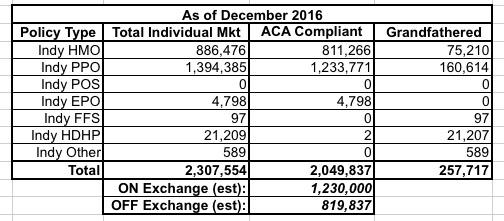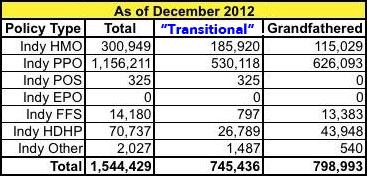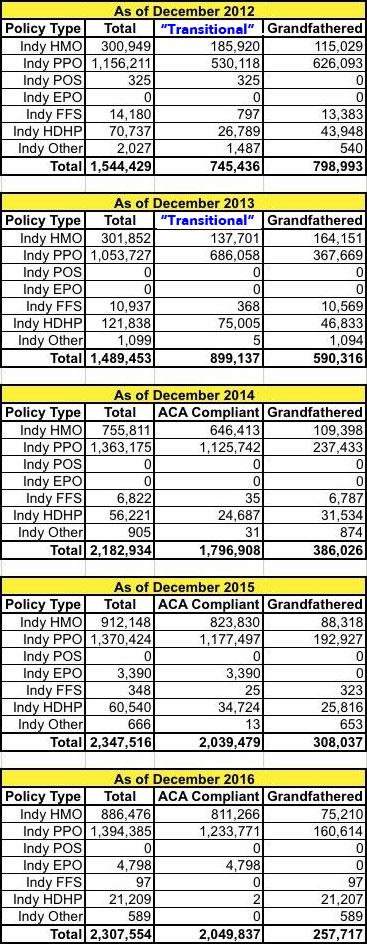UPDATE: California: Jackpot! CHCF report includes a whole mess of data, including (drumroll) grandfathered plan numbers!
The California Health Care Foundation is a nonprofit philanthropic organization. From their About page:
The California Health Care Foundation is dedicated to advancing meaningful, measurable improvements in the way the health care delivery system provides care to the people of California, particularly those with low incomes and those whose needs are not well served by the status quo. We work to ensure that people have access to the care they need, when they need it, at a price they can afford.
They seem to be pretty much on the up & up. Anyway, I need to give a huge shout-out to Ken Kelly who, via Twitter, provided me with this link to an impressively detailed report by CHCF which slices & dices up the healthcare coverage situation for the entire population of California, the largest state in the country. This report covers pretty much everything a healthcare data wonk could want to know. What's awesome is that in addition to being comprehensive, it also starts back in 2012, 2 years before the main ACA provisions kicked into effect. The only downside is that it cuts off in 2016 (I assume the 2017 data won't be added until next year).
In 2016, California health insurers covered 32.6 million enrollees — 27 million were enrolled in commercial coverage or public managed care and 5.7 million were enrolled through administrative services only (ASO) arrangements for self-insured employers. Commercial enrollment consists of small group, large group, and individual enrollment.
This set of resources — California Health Insurers, Enrollment: Quick Reference Guide, 2018 (PDF) and California Health Insurers Enrollment Database (ZIP) (published 2018) — combines enrollment data from California’s two health insurance regulators, the Department of Managed Health Care (DMHC) and the California Department of Insurance (CDI). Data are available from 2012, the first year of state-mandated enrollment reporting, through 2016. Data include information by market (e.g., individual, large group, Medi-Cal), product (e.g., HMO, PPO), regulator (DMHC and CDI), insurer (e.g., Anthem Blue Cross, Kaiser), and year.
The Excel data file (see tab "Enroll-2012-2016-Data") combines enrollment from California's two regulators — the Department of Managed Health Care (DMHC) and the California Department of Insurance (CDI) — making it a comprehensive single source of publicly available enrollment data. The regulators publicly report year-end enrollment data for the plans and insurers they regulate in compliance with provisions of AB 1083 (enacted in September 2012). The data include commercial insurance, public managed care, and administrative services only (ASO) enrollment. With information for 2012 to 2016 now available, this data file allows examination of current enrollment levels and changes over time. Statewide totals as well as drill-down detail are available. The detail allows analysis by insurer, regulator, year, market, product, and parent company grouping.
Jackpot! Again, the only bummer is that the 2017 data isn't available yet, but it is what it is. At least in terms of Covered California (the state ACA exchange), total enrollment was nearly the same from 2016 to 2017 (it dropped about 1.2%), and the subsidized percentage stayed nearly the same (it dropped from 87% in 2016 to 86% in 2017), so I'm guessing that aside from the unsubsidized rate increases and some shuffling among metal levels and carriers, things were likely fairly similar in 2017. 2018, of course, is an entirely different matter, but some of that data simply won't be available for months or possibly not for a year or more.
Even so, the CHCF spreadsheet provides a bevy of datahound goodness, including one bit of information which I've been desperately trying to track down for years in every state: How many grandfathered enrollees remain on the individual market.
As a reminder: The ACA was signed into law in March 2010. Under ACA provisions, anyone who remained continuously enrolled in a non-ACA compliant individual market policy from before then was allowed to stay enrolled in it for as long as they wanted to...assuming the insurance carrier chose to keep offering it. Any individual market policy which wasn't ACA compliant which people enrolled in after March 2010 was supposed to be terminated as of December 31, 2013, with only ACA-compliant policies being valid starting on January 1, 2014.
Every state had some people enrolled in grandfathered plans, and most also had some enrolled in transitional plans. California wisely chose not to allow transitional enrollment, so the only individual market policies available since 1/1/14 have been ACA compliant or grandfathered. However, until today, I had no idea how many grandfathered enrollees there were in CA (or most other states, for that matter).
It's a huge Excel file, and I had to dig around quite a bit to find what I was looking for. If you scroll to the last tab, it breaks out every type of healthcare coverage in California for every year from 2012 - 2016. It also breaks each of these out by insurance carrier...as well as not just type of coverage but sub-type. In other words, it has separate columns for not just the individual, small group, large group etc markets, but also for PPOs, HMOs, EPOs and so forth.
A lot of data to wade through, to be sure.
However, here's the most critical thing for me: It separates out GRANDFATHERED policies within each of those sub-categories! Eureka!
When I tallied up all of the columns, it boiled down to the following (I also included the 2016 Covered California enrollment, corrected to reflect net attrition as of the end of December, to separate out on vs. off-exchange enrollment):
BOOM. There you have it: By December 2016, California had total Individual Market enrollment of 2.31 million people, of which 257,000 were enrolled in grandfathered policies of one type or another, or around 11.2% of the total.
Of the 2.05 million enrolled in ACA-compliant policies, about 1.23 million were on the ACA exchange, leaving 820,000 enrolled in off-exchange, ACA-compliant plans.
How about in 2017? Well, as noted above, exchange enrollment stayed almost identical, only dropping 1.2%. This leads me to believe that off-exchange enrollment in ACA plans likely didn't drop much either, although likely more than 1.2% since everyone in those plans had to pay full price. I'm gonna guess it dropped perhaps 5% to around 780,000, which would mean a December 2017 total ACA indy market of around 2.0 million even.
Finally, what about grandfathered plans in 2017? Well, those numbers can only go down by definition: No one can newly enroll, and every year some of those enrolled in them drop out for various reasons (including aging into Medicare or, frankly, dying).
Fortunately, thanks to the CHCF spreadsheet dating all the way back to 2012, I was also able to find out how many people were enrolled in non-ACA compliant grandfathered plans as of December 2013, just before the new ACA regulations kicked in, and the results were a bit surprising:
According to the spreadsheet, California's total individual market was around 1.5 million people as of 2013, which makes sense...but it also indicates that about 60% of them were already enrolled in ACA-compliant policies. Huh. This is pretty surprising to me--I assumed that only a tiny percentage of individual market policies were brought up to snuff even one day before they had to do so under the law; apparently that wasn't the case in California.
UPDATE: D'OH!! OK, Louise Norris just pointed out what should have been very obvious to me: Those 900K policies were actually very likely NOT ACA-compliant, but instead were what would have been considered transitional policies instead, assuming California had allowed transitional plans to continue past 12/31/13. I've updated the tables below accordingly. Sorry for jumping the gun on this.
Just to be sure, I also went ahead and plugged in the December 2012 numbers, and sure apparently there was already a quiet shift towards ACA-compliant plans even then: 1.54 million total individual market enrollees, with 745K ACA compliant "transitional" and 799K in grandfathered plans:
The spreadsheet doesn't go back any further, but I'd be willing to bet that the "ACA compliant" column started climbing up as early as 2011. For all the fuss made over Obama's "If you like your plan you can keep it" flub (and yes, it was a mistake on his part not to include the caveats), the fact remains that insurance carriers were given four years to bring things up to snuff, but for the most part they waited until the last minute to do so and then yanked the rug out from under their enrollees all at once in October 2013. California appears to be the (partial) exception to this.
In any event, in December 2013 there were 590,000 people enrolled in grandfathered plans, which means the number dropped by 56% over the next 3 years. Assuming things continued at the same pace, as of December 2017 the grandfathered number should have been down to perhaps 200,000 as of December 2017.
UPDATE: For the hell of it, here's all 5 years in a single graphic:







